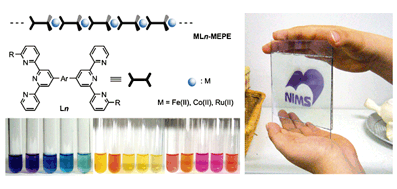M.
[Full Text PDF(J-STAGE)]
| Organic–metallic hybrid polymers consisting of bis(terpyridine)s and metal ions such as Fe(II) or Ru(II) have specific colors based on metal-to-ligand charge transfer (MLCT) absorption. Interestingly, polymer films have excellent electrochromic properties. Various colors can be observed by changing the metal species and/or by modifying the organic ligands used to synthesize the polymers. Multicolor electrochromic changes occur upon the introduction of two types of metal ions into the polymer. Electrochromic solid-state devices have been successfully fabricated by using these polymers. |
 |







